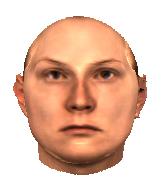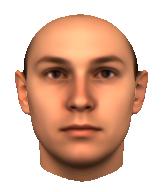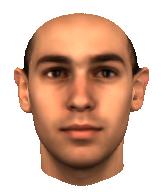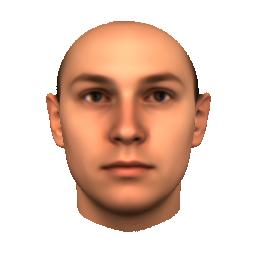| Human Visual Perception | ||||||||||||||
| Aftereffects in Perception of Faces | ||||||||||||||
|
||||||||||||||
| Morphing between two faces generates a continuous set of intermediate faces in terms of shape and surface color. Given a 3D scan of a face, say John, we can morph the face towards the average male face, reducing the strength of John's facial characteristics. In the figure above, the image "50% John" illustrates this effect. However, we can also morph John beyond the average, inverting all of his characteristics: In the figure above, anti-John has a round face, bright eyebrows, and narrow lips. In the vector-space representation of our Morphable Model of 3D Faces, these operations are very simple: John and the average male are points in face-space, and morphs are on a straight line connecting the them. | ||||||||||||||
| In order to test the hypothesis of face-space representation of faces in the human visual system, investigate the role of the average face as a prototype face, and learn more about how pictures of faces are processed in the brain, we studied visual aftereffects. In aftereffects, neurons in the brain adapt their response after being exposed to an intense stimulus for some time. This daptation continues for a short period of time even when a new stimulus is presented. As a result, the person has a different perception than if the first stimulus had not been shown. Adaptation experiments, therefore, help to relate human perceptual experience, measured in psychophysical experiments, to the properties of neural populations. | ||||||||||||||
| In our experiment, participants learned to recognize four individuals (John, Adam, Jim and Henry) . Then, they adapted to an anti-face, say anti-John. When shown the average face immediately afterwards and asked who's face they saw, participants reported having seen John in more than 60% of trials. Without showing anti-John, the percentage was 25% (chance level). | ||||||||||||||
| Our results indicate that the face space reflects some of the properties of human perception, since the images of anti-John and John are related in a way defined by that vector space. The average face seems to play an important role in encoding faces. Unlike many other well-known aftereffects, the specificity to individual faces indicates that the adaptation occurs on a high level of visual processing, such as in inferotemporal cortex. | ||||||||||||||
|
||||||||||||||
| Lit: Prototype-referenced shape encoding revealed by high-level aftereffects. Leopold, D. A., O'Toole, A. J., Vetter, T. and Blanz, V. Nature Neuroscience 4(1), pp 89-94, 2001 pdf |
||||||||||||||
| |
||||||||||||||
© Universitiy of Siegen, Chair of Media Informatics 2022© Sascha Nesch 2009





